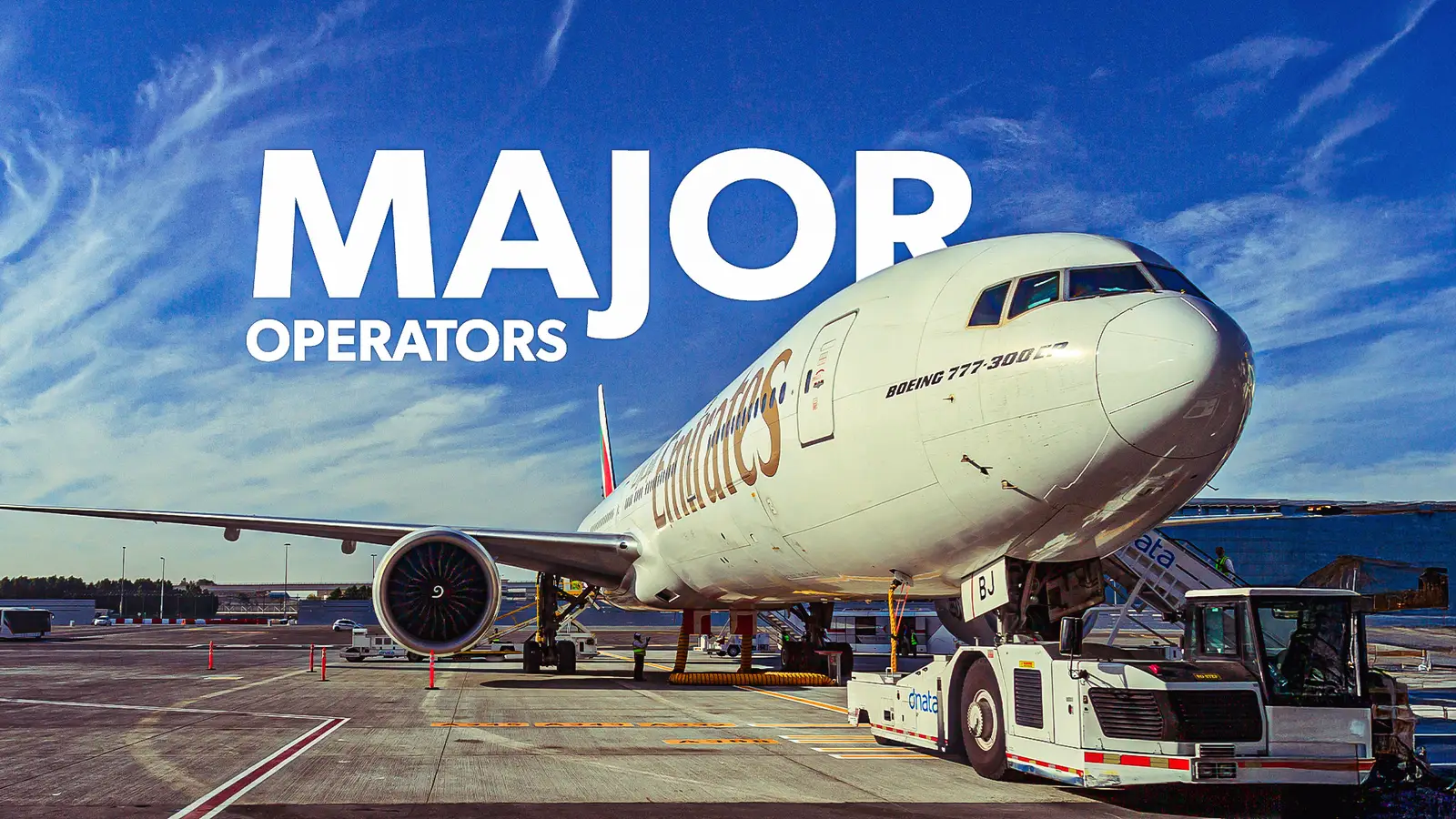
The aviation publication The Aviation Briefhas utilized data from Planespotters.net to show the top-five airlines according to widebody aircraft fleet size, including Emirates, United Airlines, Qatar Airways, Delta Air Lines, and Turkish Airlines. A widebody aircraft is defined as one that has two aisles, and these are, therefore, the jets that dominate long-hauland high-capacity flying, often to the world’s most significant hubs.This article goes into depth on each of the top five airlines by
widebodyfleet size. It includes information on aircraft currently in the fleets and how they are used, alongside those that are on order. There is also detail on the experience you can expect to find on board.
Emirates Has An A380-Driven Fleet
At the head of the table is the Dubai giant Emirates. This carrier’s widebody-only fleet includes 140 Boeing 777s, 116 Airbus A380s, and 8 Airbus A350s. The latter is a growing part of the fleet that will help define the airline’s direction moving forward. The carrier also has a number of widebody orders pending, including commitments for 56 A350-900s, 35 777-8s, 170 777-9s, 20 787-8s, and 15 787-10s. This will allow the airline to update its aging 777 variants, with deliveries planned from 2025 to 2030.
Most notable for Emirates is its impressive collection of A380s, considered by many to be the industry’s most iconic jet. It has been a leading carrier throughout this aircraft’s history, and it received the final A380 in December 2021, marking the 123rd aircraft of the type delivered to Emirates. Registered as A6-EVS, the A380 took to the skies at 16:40 as the sun was setting over Hamburg. The aircraft traveled north to skim UK airspace before turning towards its new operating base in Dubai.
Despite COVID-19 restrictions, avgeeks from around the world were able to gather at the airport’s perimeter fence to watch the aircraft depart. With Emirates having put in a hefty 777X order, we can expect the appearance of its widebody fleet to move away from the A380 over the coming years. The order is a clear commitment to the range, comfort, fuel efficiency, and reduced air and noise pollution associated with modern aircraft.
United Airlines Prides Itself On Widebody Variety
Next in the list is United, an airline with a broad variety across its 227 widebody aircraft. This part of its fleet includes Boeing 767s, Boeing 777s, and Boeing 787s. The airline has 37 767-300ERs, 16 767-400ERs, 19 777-200s, 55 777-200ERs, 22 777-300ERs, 12 787-8s, 46 787-9s, and 21 787-10s, and United has hedged a lot of its future on the 787. Indeed, the carrier has 142 787-9s on order, preparing for this jet to allow the carrier to phase out its 767s.
These orders demonstrate continuing confidence in a jet that joined United by accident. The airline acquired its original 787s when it got Continental Airlines’ firm commitments during the two carriers’ merger. Among the three US-based airlines that fly the 787 (United, Hawaiian, and American Airlines) United is unique in operating the 787-10. This larger variant is substantially rarer than other Dreamliners, and Boeing has sold 1,000 fewer 787-10s than 787-9s
However, United also has orders for 45 A350-900s, which are intended to replace the aging Boeing 777-200ERs. Boeing would have hoped that United might have looked to the 777X as a potential replacement, but, like its fellow US carriers, United remains uninterested in the heavily delayed aircraft.
Inside Qatar Airways’ Modern Fleet
Qatar Airways’ 199 widebody aircraft are almost exclusively next-generation jets. Its fleet includes A350-900s (34 aircraft), A350-1000s (24 aircraft), 787-8s (32 aircraft), and 787-9s (23 aircraft). Older aircraft include 56 777-300ERs and a few Airbus A380s (eight aircraft) and 777-200LRs (seven aircraft). The carrier also has 18 A350-1000s, 90 777-9s, 62 787-9s and 75 787-10s on order. It is the fulfillment of Qatar’s order of 227 Boeing aircraft that will define the direction of its widebody fleet in the coming years.
Back in May of 2025, Simple Flying covered the $96 billion order for 160 787s and 777Xs made by Qatar during Trump’s visit to the Gulf state. Trump himself revealed the order at a press conference, saying that “Kelly’s telling me from Boeing that it’s the largest order of jets in the History of Boeing. That’s pretty good. […] That’s a record, Kelly, and congratulations to Boeing. Get those planes out there, get them out there.” The announcement led to a rise in Boeing’s share price of 3.1%.
Despite its numerical commitment to Boeing widebody aircraft, Qatar Airways remains important in the history of the A350. That is because the carrier was the launch customer for the Airbus A350-1000. Qatar Airways received its first A350 airframe in February 2018 and has continued to receive deliveries of the aircraft since then. It flies this jet at exceptionally high frequency from Doha to a range of popular destinations in the United States of America.
These include Dallas/Fort Worth (two daily), Miami (ten weekly), Atlanta (daily), Houston (daily), Los Angeles (daily), and San Francisco (daily). The route to Los Angeles is notable as the US’s longest A350-1000 route by block time. However, Qatar Airways has also cut back on select services using the A350-1000. For example, the airline no longer uses the jet for flights to Auckland.
Delta Air Lines’ Widebody Versatility
Delta Air Lines’ widebody aircraft fleet is based on versatility across the 176 aircraft, designed to offer strong transatlantic coverage. The fleet features 11 A330-200s, 31 A330-300s, 37 A330-900neos, 38 A350-900s, 39 767-300ERs, and 21 767-400ERs. The airline is notable for the absence of significant widebody orders, which are limited to 20 A350-1000s, 6 A350-900s, and 2 A330-900neos. Delta’s CEO, Ed Bastian, described the reasoning for the firm commitment to A350s:
“The A350-1000 will be the largest, most capable aircraft in Delta’s fleet and is an important step forward for our international expansion. The aircraft complements our fleet and offers an elevated customer experience, with more premium seats and best-in-class amenities, as well as expanded cargo capabilities.”
Meanwhile, Airbus’ Chief Executive Officer of the Commercial Aircraft business, Christian Scherer, said that “we are thankful for Delta’s continued confidence in Airbus’ solutions to meet its fleet needs. Delta now welcomes the A350-1000, which will open even more opportunities for the airline and its customers. We are proud that our aircraft serve the entirety of Delta’s impressive global network as this stellar airline takes fleet efficiency to the next level.”
Unlike the carrier’s modest widebody Airbus order, Delta has huge narrowbody orders, primarily with Boeing. This includes 100 737 MAX 10s, set for delivery to begin in late 2027, with options to buy 30 more. Delta says that it has selected the 10 due to its “broad flexibility to serve markets across the US within Delta’s industry-leading network.” Modern narrowbodies like the 10 often have sufficient range to operate routes that were once only imaginable for widebodies, albeit with fewer seats.
Turkish Airlines Uses Widebodies To Connect The World From Istanbul
Turkish Airlines uses its fleet of 154 widebody aircraft to connect its Istanbul hub to a range of destinations in Africa, Europe, Asia, and the Americas. Its widebody fleet has an impressive variety of both Airbus and Boeing planes. This includes 12 A330-200s, 37 A330-300s, 29 A350-900s, 34 777-300ERs and 24 787-9s. Meanwhile, Turkish Airlines has 15 A350-1000s and 6 787-9s on order, indicating little desire for a large-scale modernization or growth of its widebody fleet.
Back in 2022, Simple Flying’s Chris Loh experienced a trip flying aboard a Turkish Airlines 777 in domestic economy, finding that the aircraft’s two-class cabin was outdated compared with KLM and Air France’s 777s. However, the seats were spacious and comfortable, aided by a footrest. The aircraft also had seat-back in-flight entertainment systems, but the screens were outdated and offered a poor-quality viewing experience. Luckily, the flight was short enough not to need to use it.
Passengers can expect a more modern experience when flying aboard Turkish Airlines’ fleet of 787-9s. Simple Flying’s Sumit Singh reflects on this from his experience as a guest flying in business class with Turkish Airlines from Istanbul to Dubai, when he found that the in-flight entertainment system was modern and had a broad enough range to keep him entertained. The seat also had a great charging port and fast (if sometimes patchy) WiFi.
There was also a good experience on the ground because of Turkish Airlines’ dominance at Istanbul Airport. Connecting onto the flight to Dubai was easy after touchdown in Istanbul. Touching on this, Sumit concluded that “Considering the ease of transiting through Istanbul Airport and the comfort to be had on board the aircraft, Turkish Airlines’ 787-9 business class is an excellent solution for connecting to Dubai.”



